
DSB, an abbreviation of Danske Statsbaner, is the largest Danish train operating company, and the largest in Scandinavia. While DSB is responsible for passenger train operation on most of the Danish railways, goods transport and railway maintenance are outside its scope. DSB runs a commuter rail system, called the S-train, in the area around the Danish capital, Copenhagen, that connects the different areas and suburbs in the greater metropolitan area. Between 2010 and 2017, DSB operated trains in Sweden.

The Aarhus School of Architecture was founded in 1965 in Aarhus, Denmark. Along with the Royal Danish Academy of Fine Arts, School of Architecture in Copenhagen, it is responsible for the education of architects in Denmark. The school has approximately 750 students.

The Potato Germans (Kartoffeltyskere) were a group of German families who settled in the heathlands of central Jutland in Denmark during the mid-1700s. The term is sometimes also extended to their descendants.
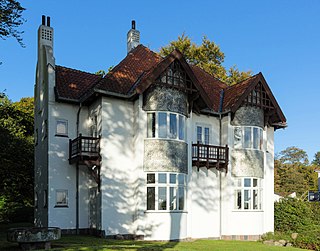
Villa Kampen is a listed building in Aarhus, Denmark, constructed by architect Hack Kampmann between 1901 and 1902, during his tenure as the Royal Building Inspector for Northern Jutland. Villa Kampen is a villa situated in Midtbyen in central Aarhus, in the affluent neighbourhood around Strandvejen south of the neighbourhood Marselisborg. It lies next to Havreballe Forest behind it and to the west, with an east-facing view of Tangkrogen and the Bay of Aarhus in front of it and the Marselisborg Forests visible on the hills to the south. The building and the surrounding estate was listed on 2 March 1983 by the precursor to the Danish Heritage Agency.

Lyngbygård is a manor house and a listed building in Aarhus Municipality, Denmark. The estate is 225 hectares of land situated by Lyngbygård River, 4 km. west of Tilst in Aarhus. The manor building was listed by the Danish Heritage Agency on 9 July 1918.

Hasle Church is a church located in Hasle Parish in Aarhus, Denmark. The church is located 3 km. west of Aarhus city centre and north of Åbyhøj. It is a parish church within the Church of Denmark servicing a parish population of 7.515 (2015).

Aarhus Old City Hall is the former city hall of Aarhus, Denmark, and a listed building. The city hall was built in 1857 and was listed in the Danish national registry of protected buildings and places by the Danish Heritage Agency on 18 March 1996. It is the second, and oldest preserved, city hall of Aarhus.

Domkirkepladsen 1 is a listed building and the former Bank of Denmark branch building in Aarhus, Denmark. The bank was built in 1926 and was listed in the Danish national registry of protected buildings and places by the Danish Heritage Agency on 22 February 1996. The bank is situated on the Store Torv square in the central Indre by neighbourhood next to the cathedral where it has functioned as a bank since its completion until today. The building is no longer in use by the Bank of Denmark but still functions as a bank, occupied by a branch of Nykredit.
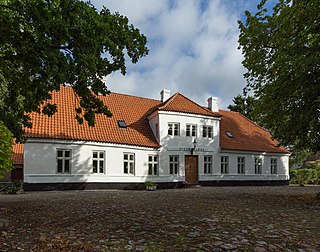
Jarlsminde is a farm and a listed building in Aarhus, Denmark. The farm was built in 1798 and was listed in the Danish national registry of protected buildings and places by the Danish Heritage Agency on 3 June 1997. The farm is situated in the suburb Stavtrup about 7-8 km. south-west of the city centre of Aarhus where it sits on a hill with a view of Brabrand Lake and the large urban areas on the other side of it.
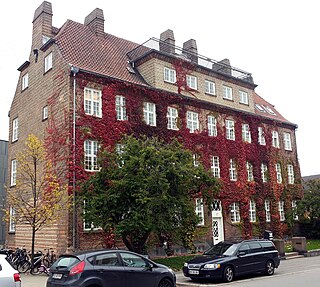
The Baumann House is a listed building in Aarhus, Denmark. The building was constructed in 1911 and was listed in the national Danish registry of protected buildings and places by the Danish Heritage Agency on 18 September 1996. The building is situated in the central Indre By neighborhood on Jægergårdsgade adjacent to the Aarhus Central Workshops.

Juul's House is a house and a listed building in Aarhus, Denmark. The house was built in 1629 and was listed on the national Danish registry of protected buildings and places by the Danish Heritage Agency on 1 April 1984. The building is one of the oldest in the city and it is situated in the historical Latin Quarter on Mejlgade. It has been a paint shop since 1842 and it is the oldest paint shop in the country.

Badstuegade 1H is a house and a listed building in Aarhus, Denmark. The house was built in 1809 and was listed on the Danish registry of protected buildings and places by the Danish Heritage Agency on 7 October 1970. The house is situated in the historic and central Latin Quarter neighbourhood on Badstuegade by Pustervig square.
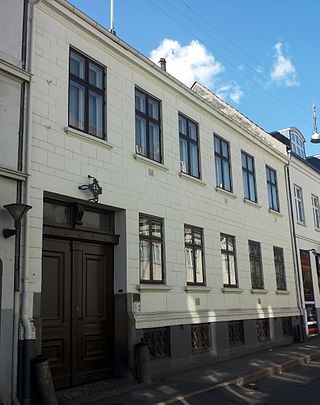
Hans Broge's House is a house and a listed building in Aarhus, Denmark. The house was built in 1850 and was listed on the Danish registry of protected buildings and places by the Danish Heritage Agency on 6 September 1987. The house is situated in the historic Indre by neighborhood on Mindegade close to the harbor and the Port of Aarhus.

Åboulevarden 69 or Ny Jydske Kjøbstad Creditforening is a building in the city of Aarhus, Denmark, located in the Indre By neighborhood in the Midtbyen district on the street Åboulevarden. The building was constructed in 1910 for the credit union Ny Jydske Kjøbstad Creditforening, a name which still adorns the facade of the building. The building has functioned as a financial institution since it was built and as of 2016 was owned by Steen Mengel and rented to Danske Bank, who use it for their main Aarhus branch.

The Aarhus Courthouse is a historic building located on Vester Allé in Aarhus, Denmark. Originally built as a combined Courthouse and jail, it now serves as the seat of Aarhus County Court while the High Court of Western Denmark, based in Viborg, has a courtroom there. Inaugurated in 1906, it was built to the design of L.A. Ludvigsen and Julius Hansen in the Art Nouveau style.
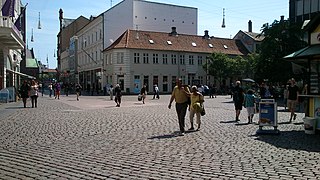
Lille Torv is a cobbled public square located in the Indre By neighborhood in Aarhus, Denmark. It is situated between the squares of Store Torv and Immervad in the historic Latin Quarter neighborhood and it is one of the oldest public squares in Aarhus. The streets of Vestergade, Guldsmedgade, Immervad and Badstuegade radiates from Lille Torv. It is today a venue for public events and gatherings in the city. The square is home to some notable buildings such as the storied Meulengracht's House and the listed Business- and Agricultural Bank of Jutland.

David Baruch Adler was a Jewish-Danish banker, politician and philanthropist. He founded Kjøbenhavns Handelsbank in 1875.
The 1927–28 JBUs Mesterskabsrække was the 30th season of the Jutland Football Championship since its establishment in 1902. The season was launched in August 1927 and concluded in May 1928 with the final match of the regular league fixtures, while the championship play-offs and promotion/relegation play-off matches were held in May and June 1928. Aalborg BK won both final matches, securing their 4th Jutland league championship and qualifying for the 1928 Provinsmesterskabsturneringen, which they also won. Holstebro BK and BK Herning Fremad were relegated and replaced by Brønderslev IF and Haderslev FK from the 1927–28 JBUs A-række. In the 1927 JBUs Pokalturnering, Aalborg BK obtained their fourth consecutive cup championship, by winning the final against Esbjerg fB.
Jutland Series is the highest division for men organized by the regional association DBU Jylland and one of the fifth-highest divisions overall in the Danish football league system. The Jutland Association Football Championship was introduced in 1902. At the introduction of the championship, the tournament was placed at the top of the Danish football league system, but has since been moved to its current status as the fifth best level in Danish football, after a short period as the sixth best level, below the Denmark Series at the fourth level.

Laksegade 26 is a Neoclassical property situated at the corner of Laksegade and Nikolajgade in central Copenhagen, Denmark. It was listed in the Danish registry of protected buildings and places in 1939. A plaque on the facade towards Laksegade commemorates that the architect Theophilus Hansen was born in the building.




















